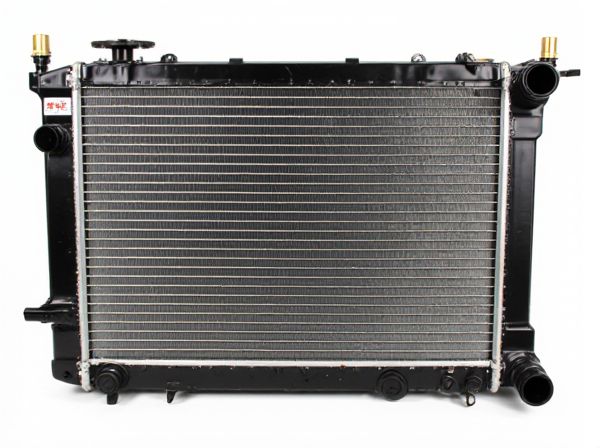
Photo illustration: Brazed Radiator vs Mechanically Assembled Radiator
Brazed radiators offer superior thermal performance and durability due to their strong, seamless construction, making them ideal for high-pressure cooling systems. Mechanically assembled radiators provide easier maintenance and repair options with detachable parts but may suffer from potential leakage over time. Choosing the right radiator depends on your system's pressure requirements and maintenance preferences.
Table of Comparison
| Feature | Brazed Radiator | Mechanically Assembled Radiator |
|---|---|---|
| Construction | Seamless copper brazing for strong, leak-proof joints. | Bolted or clamped parts, prone to loosening over time. |
| Durability | High durability with excellent corrosion resistance. | Moderate durability, susceptible to joint wear and leaks. |
| Cooling Efficiency | Superior thermal conductivity due to solid joints. | Lower cooling efficiency from potential air gaps. |
| Maintenance | Low maintenance; difficult to disassemble. | Easy disassembly for cleaning and repair. |
| Cost | Higher initial cost due to complex fabrication. | Lower initial cost and easier manufacturing. |
| Weight | Generally lighter, improving vehicle fuel efficiency. | Typically heavier due to mechanical fasteners. |
Introduction to Radiator Technologies
Brazed radiators utilize a fusion process that combines multiple metal layers into a single, highly conductive unit, enhancing heat transfer efficiency and providing superior durability under high pressure conditions. Mechanically assembled radiators consist of individual components, such as tubes and fins, joined by screws or clamps, allowing easier maintenance and flexibility in customization. Each technology impacts thermal performance, manufacturing cost, and repairability, influencing their suitability across automotive and industrial cooling applications.
What Is a Brazed Radiator?
A brazed radiator is a type of heat exchanger constructed by joining thin metal plates using a high-temperature alloy, typically brass or copper, through a brazing process that ensures a strong, leak-proof bond. This manufacturing technique results in a compact, durable unit capable of withstanding high pressures and temperatures, making it ideal for automotive and industrial cooling systems. Unlike mechanically assembled radiators, brazed radiators offer enhanced thermal efficiency and corrosion resistance due to their seamless integration and precision engineering.
Understanding Mechanically Assembled Radiators
Mechanically assembled radiators consist of multiple individually fabricated components joined through mechanical fastening methods such as bolts, clamps, or screws, allowing for easier repair and part replacement compared to brazed radiators. These radiators are widely used in automotive and industrial applications where maintenance flexibility and modularity are critical for operational efficiency. Although mechanically assembled radiators may have slightly higher leakage risks and lower thermal efficiency than brazed types, their durability and serviceability make them ideal for heavy-duty environments.
Material Composition and Design Differences
Brazed radiators typically feature copper or brass cores with aluminum fins, offering superior thermal conductivity and corrosion resistance due to their seamless construction. Mechanically assembled radiators combine materials such as aluminum, plastic tanks, and steel cores, relying on joints and fasteners that may reduce durability and heat transfer efficiency. Design-wise, brazed radiators provide enhanced structural integrity and compactness, while mechanically assembled radiators allow easier repairs and part replacements but may sacrifice overall performance.
Thermal Performance Comparison
Brazed radiators offer superior thermal performance due to their enhanced heat transfer capabilities, attributed to the strong metal-to-metal bonds formed during the brazing process, which minimize thermal resistance. Mechanically assembled radiators often exhibit lower thermal efficiency because the joints rely on fasteners or seals that can create gaps, reducing effective heat conduction. Studies show brazed designs can achieve up to 15-20% higher heat dissipation rates compared to mechanically assembled counterparts under similar operating conditions.
Durability and Longevity Analysis
Brazed radiators offer superior durability and longevity due to the continuous metal bond created by high-temperature brazing, resulting in enhanced resistance to leaks and thermal fatigue compared to mechanically assembled radiators. Mechanically assembled radiators rely on seals and fasteners, which are more susceptible to wear, corrosion, and mechanical failure over time, lowering their operational lifespan. Industry data indicates brazed radiators typically maintain optimal performance for 15-20 years, while mechanically assembled counterparts often require replacement or major maintenance within 8-12 years.
Maintenance and Repair Considerations
Brazed radiators offer superior durability with fewer leak issues due to their strong, permanent joints, reducing the frequency of maintenance and repair. Mechanically assembled radiators require more frequent inspection because the bolts and seals can loosen or degrade, leading to leaks or the need for gasket replacement. Repairing brazed radiators is often more complex and costly, necessitating specialized welding equipment, whereas mechanically assembled radiators allow for easier disassembly and part replacement.
Cost Implications: Upfront and Lifetime
Brazed radiators typically have higher upfront costs due to advanced manufacturing processes involving high-precision brazing techniques that ensure stronger, more durable joints and enhanced resistance to corrosion. Mechanically assembled radiators generally offer lower initial costs but may incur higher lifetime expenses because mechanical joints are more prone to leaks, requiring frequent maintenance or earlier replacement. Over the lifetime, brazed radiators tend to provide better cost efficiency through reduced maintenance, longer service life, and improved thermal performance, offsetting the initial investment.
Applications and Industry Usage
Brazed radiators are predominantly used in automotive and industrial sectors requiring high thermal efficiency and durability, such as heavy-duty trucks, construction machinery, and power generation equipment. Mechanically assembled radiators find extensive application in agricultural machinery, commercial vehicles, and HVAC systems due to their ease of repair and cost-effectiveness. The choice hinges on operational demands: brazed radiators excel in high-pressure, high-temperature environments, while mechanically assembled units offer flexibility in maintenance and lower upfront costs.
Choosing the Right Radiator for Your Needs
Brazed radiators offer superior heat transfer efficiency and durability due to their seamless construction, making them ideal for high-performance cooling systems in automotive and industrial applications. Mechanically assembled radiators provide easier repair and customization options, suitable for flexible maintenance budgets and environments where quick part replacements are essential. Selecting the right radiator depends on factors such as thermal performance requirements, maintenance capabilities, and cost considerations unique to each use case.
 caratoz.com
caratoz.com